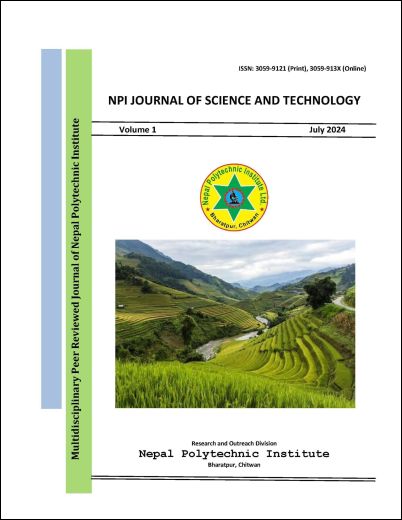Finite Element Analysis of CFFT and CFDTS Columns as a Replacement for CFST Columns in Composite Construction by Using ABAQUS
DOI:
https://doi.org/10.3126/npijst.v1i1.68950Keywords:
CFST columns, CFFT columns, CFDTS columns, GFRP tube, Finite Element AnalysisAbstract
In the field of composite construction of steel and concrete, concrete filled steel tube CFST columns have been proven to be greater performance structural members. The properties of steel and concrete are used efficiently. But CSFT columns are prone to corrosion in outdoor structures as the outer encasing tube is made up of steel. The outdoor use of CFST column due to its high risk of corrosion requires frequent maintenance and may prove costly. Hence, the possible replacement of steel tubes with fiber-reinforced polymer (FRP) Tubes has to be investigated. FRPs are the most suitable material for encasing concrete columns due to its orthotropic behaviour. In solution to this, the paper is aimed at numerical study of CFST, CFFT and CFDTS short columns to study the axial compression behavior of these short columns analytically and examine the best suitable alternatives of CFST column. The concrete in-fill double tube section CFDTS with better axial compression, stiffness and ductility are also investigated as a suitable replacement of CFST columns. For these three different specimens of CFST columns of steel tube thickness 3mm, 4.5mm and 6mm, CFFT columns of GFRP tube thickness 3mm, 4.5mm and 6mm and CFDTS column with GFRP outer tube of thickness 3mm, 4.5mm and 6mm as well as inner steel tube of thickness 1.5mm, 2mm and 2.5mm are analyzed and compared. Consequently, CFDTS columns, with 1872 kN are proven to be superior to CFST columns with axial capacity 1653 kN and CFFT with axial capacity 689 kN columns. The confinement effect in CFDTS is more than CFST and CFFT column.
Downloads
Downloads
Published
How to Cite
Issue
Section
License
All rights reserved. No part of this publication may be reproduced, distributed, or transmitted in any form or by any means, including photocopying, recording, or other electronic or mechanical methods, without the prior written permission of the publisher, except in the case of brief quotations embodied in critical reviews and certain other non-commercial uses permitted by copyright law.




